.jpg) Aging, sun damage, pregnancy, significant fluctuations in weight, and genetic factors may contribute to poor tissue elasticity that can result in sagging of the abdomen, buttocks and thighs. A body lift improves the shape and tone of the underlying tissue that supports fat and skin. Excess sagging fat and skin are removed and the procedure(s) can improve a dimpled, irregular skin surface, which is commonly known as cellulite.
Aging, sun damage, pregnancy, significant fluctuations in weight, and genetic factors may contribute to poor tissue elasticity that can result in sagging of the abdomen, buttocks and thighs. A body lift improves the shape and tone of the underlying tissue that supports fat and skin. Excess sagging fat and skin are removed and the procedure(s) can improve a dimpled, irregular skin surface, which is commonly known as cellulite.
Body lifts are surgical procedures and they require extensive incisions. Incision length and pattern depend on the amount and location of excess skin to be removed, as well as surgical judgment. Advanced techniques usually allow incisions to be placed in strategic locations where they can be hidden by most types of clothing and swimsuits.
A body lift may include these areas:
- Abdominal area – locally or extending around the sides and into the lower back area
- Buttocks that may be low, flat or shaped unevenly
- Groin that may sag into inner thigh
- Thigh – the inner, outer, or posterior thigh, or the thigh’s circumference
Body lifts are not intended strictly for the removal of excess fat. Liposuction alone can remove excess fat deposits where skin has good elasticity and is able to naturally conform to new body contours. In cases where skin elasticity is poor, a combination of liposuction and body lift techniques may be recommended.
Enhancing your appearance with a body lift
 A well-toned body with smooth contours often is a sign of fitness achieved by healthy diet and exercise.
A well-toned body with smooth contours often is a sign of fitness achieved by healthy diet and exercise.
But exercise cannot always achieve desired results for people who have loose, sagging skin and uneven contours. Aging, sun damage, pregnancy and significant fluctuations in weight as well as genetic factors may contribute to poor tissue elasticity and can result in sagging of the abdomen, buttocks, thighs and upper arms.
If you desire a firmer, more youthful-looking body contour, then a surgical body lift may help achieve your goals. It improves the shape and tone of the underlying tissue that supports fat and skin.
Excess sagging fat and skin are removed to treat conditions caused in part by poor tissue elasticity. In addition, the procedure(s) can improve a dimpled, irregular skin surface, commonly known as cellulite.
In general, candidates for a body lift include:
- Individuals with significant soft tissue looseness in one or multiple body areas
- Healthy individuals without medical conditions that impair healing or increase risk of surgery
- Individuals with a positive outlook and realistic goals for what body lift surgery can accomplish
- Non-smokers
- Individuals committed to leading a healthy lifestyle with proper nutrition and fitness
A body lift may include these areas:
- Abdominal area, locally or extending around the sides and into the lower back area
- Buttocks, that may be low, flat or shaped unevenly
- Groin that may sag into the inner thigh
- Thigh, including the inner, outer, or posterior thigh, or circumferentially
The success and safety of your body lift procedure depends very much on your complete candidness during your consultation. You’ll be asked a number of questions about your health, desires and lifestyle.
 Be prepared to discuss:
Be prepared to discuss:
- Why you want the surgery, your expectations and desired outcome
- The options available in body lift surgery
- Medical conditions, drug allergies and medical treatments
- Use of current medications, vitamins, herbal supplements, alcohol, tobacco and drugs
- Previous surgeries
Your surgeon may also:
- Evaluate your general health status and any pre-existing health conditions or risk factors
- Examine and measure your body, including detailed measurements
- Take photographs for your medical record
- Discuss your options and recommend a course of treatment
- Discuss likely outcomes of body lift surgery and any risks or potential complications
Prior to surgery, you may be asked to:
- Get lab testing or a medical evaluation
- Take certain medications or adjust your current medications
- Stop smoking well in advance of surgery
- Avoid taking aspirin, anti-inflammatory drugs and herbal supplements as they can increase bleeding
Special instructions you receive will cover:
- What to do on the day of surgery
- The use of anesthesia during your body contouring surgery
- Post-operative care and follow-up
Your plastic surgeon will also discuss where your procedure will be performed. Body lift surgery may be performed in an accredited office-based surgical center, outpatient or ambulatory surgical center, or a hospital.
What happens during body lift surgery?
Step 1 -Anesthesia
Medications are administered for your comfort during the surgical procedure. The choices include intravenous sedation and general anesthesia. Your doctor will recommend the best choice for you.
Step 2 – The incision
Incision length and pattern depend on the amount and location of excess skin to be removed, as well as personal preference and surgical judgment.
A complete lower body lift treats the buttocks, abdomen, waist, hips and thighs in one procedure. One common technique of complete lower body lift uses incisions similar to a bikini pattern to tighten the abdomen, groin, waist, thigh, and buttock in one procedure. An incision around the circumference of the body removes an apron of excess skin and fat while repositioning and tightening tissues.
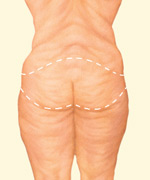
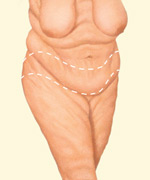
A combination of liposuction and surgical body lifts may be necessary to achieve an improved contour. Deep support sutures within underlying tissues help to form the newly shaped contours. Sutures, skin adhesives, tapes, or clips close the skin incisions.
Step 3 – Closing the incisions
Sutures, skin adhesives or tapes close the skin incisions.
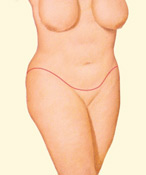
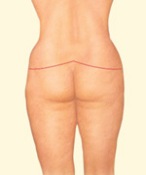
Step 4 – See the results
The results of a body lift are visible almost immediately. It may take as long as one to two years for the final results to fully develop.
The decision to have a body lift is extremely personal. You will have to decide if the benefits will achieve your goals and if the risks and potential complications are acceptable. Your plastic surgeon and/or staff will explain in detail the risks associated with surgery. You will be asked to sign consent forms to ensure that you fully understand the procedure you will undergo and any risks or potential complications.
Possible risks of body lift surgery include:
- Anesthesia risks
- Bleeding (hematoma)
- Infection
- Poor wound healing
- Fluid accumulation (blood or serum)
- Numbness or other changes in skin sensation
- Fatty tissue found deep in the skin might die (fat necrosis)
- Pain, which may persist
- Recurrent looseness of skin
- Persistent swelling in the legs
- Asymmetries
- Deep vein thrombosis, cardiac and pulmonary complications
- Possible need for revisional surgery
- Skin loss
- Sutures may spontaneously surface through the skin, become visible or produce irritation and require removal
- Unfavorable scarring
.jpg) Is it right for me?
Is it right for me?
Before you decide to undergo body lift surgery, your weight must be relatively stable. Women considering future pregnancies should postpone an abdominal body lift since pregnancy may diminish the results.
Good candidates for body lift surgery are:
- Individuals with significant soft tissue looseness in one or multiple body areas
- Healthy individuals who do not have medical conditions that can impair healing or increase risk of surgery
- Non-smokers
- Individuals with a positive outlook and realistic goals for what body lift surgery can accomplish
- Individuals committed to leading a healthy lifestyle including proper nutrition and fitness
Be sure to ask questions:
It’s very important to ask your plastic surgeon questions about your body lift procedure. It’s natural to feel some anxiety, whether it’s excitement for your anticipated new look or a bit of preoperative stress. Don’t be shy about discussing these feelings with your plastic surgeon.
After your body lift procedure is completed, dressings or bandages will be applied to the incisions. A small, thin tube may be temporarily placed under the skin to drain any excess blood or fluid that may collect.
You will be given specific instructions that may include: How to care for your surgical site(s) following surgery, medications to apply or take orally to aid healing and reduce the risk of infection, specific concerns to look for at the surgical site or in your general health, and when to follow up with your plastic surgeon.
Be sure to ask your plastic surgeon specific questions about what you can expect during your individual recovery period.
- Where will I be taken after my surgery is complete?
- What medication will I be given or prescribed after surgery?
- Will I have dressings/bandages after surgery?
- When will they be removed?
- Are stitches removed? When?
- When can I resume normal activity and exercise?
- When do I return for follow-up care?
When you go home
If you experience shortness of breath, chest pains, or unusual heart beats, seek medical attention immediately. Should any of these complications occur, you may require hospitalization and additional treatment.
The practice of medicine and surgery is not an exact science. Although good results are expected, there is no guarantee. In some situations, it may not be possible to achieve optimal results with a single surgical procedure and another surgery may be necessary. Be careful
Following your physician’s instructions is key to the success of your surgery. It is important that the surgical incisions are not subjected to excessive force, abrasion, or motion during the time of healing. Your doctor will give you specific instructions on how to care for yourself.
.jpg) The results of a body lift are visible almost immediately. However, it may take two years or more for the final results of the body lift procedures
The results of a body lift are visible almost immediately. However, it may take two years or more for the final results of the body lift procedures
to fully develop. Some visible scars will remain, but the overall results are long lasting, provided that you maintain a stable weight and general fitness.
As your body ages, it is natural to lose some firmness. However, most of your initial improvement should be relatively permanent. Although good results are expected from your procedure, there is no guarantee. In some situations, it may not be possible to achieve optimal results with a single surgical procedure and another surgery may be necessary.
- Abdominoplasty: A surgical procedure to correct the apron of excess skin hanging over your abdomen.
- Circumferential incision: A surgical incision around the body to remove the “belt” of excess skin and fat and additional incisions that may resemble a bikini bottom pattern.
- Circumferential thigh lift: A surgical procedure to correct sagging of the outer and mid-thigh.
- General anesthesia: Drugs and/or gases used during an operation to relieve pain and alter consciousness.
- Hematoma: Blood pooling beneath the skin.
- Intravenous sedation: Sedatives administered by injection into a vein to help you relax.
- Liposuction: Also called lipoplasty or suction lipectomy, this procedure vacuums out fat from beneath the skin’s surface to reduce fullness.
- Local anesthesia: A drug injected directly to the site of an incision during an operation to relieve pain.
- Lower body lift: Surgical procedure to correct sagging of the abdomen, buttocks, groin and outer thighs.
- Macerated skin: Excess skin that hangs and becomes wet or infected underneath.
- Medial thigh lift: A surgical procedure to correct sagging of the inner thigh.
- Sutures: Stitches used by surgeons to hold skin and tissue together.
- Tummy tuck: A surgical procedure to correct the apron of excess skin hanging over your abdomen.
Cost is always a consideration in elective surgery. Prices for body lifts can vary widely. A surgeon’s cost for body lift surgery may vary based on his or her experience as well as geographic office location.
Many plastic surgeons offer patient financing plans, so be sure to ask.
.jpg) Costs may include:
Costs may include:
- Surgeon’s fee
- Hospital or surgical facility costs
- Anesthesia fees
- Prescriptions for medication
- Post-surgery garments, and
- Medical tests
Your satisfaction involves more than a fee
When choosing a plastic surgeon for a body lift, remember that the surgeon’s experience and your comfort with him or her are just as important as the final cost of the surgery.
Most health insurance does not cover cosmetic surgery or its complications.
Use this checklist as a guide during your consultation
- Are you certified by the American Board of Plastic Surgery?
- Are you a member of the American Society of Plastic Surgeons?
- Were you specifically trained in the field of plastic surgery?
- How many years of plastic surgery training have you had?
- Do you have hospital privileges to perform this procedure? If so, at which hospitals?
- Is the office-based surgical facility accredited by a nationally or state-recognized accrediting agency, or is it state-licensed or Medicare-certified?
- Am I a good candidate for this procedure?
- What will be expected of me to get the best results?
- Where and how will you perform my procedure?
- What surgical technique is recommended for me?
- How long of a recovery period can I expect and what kind of help will I need during my recovery?
- What are the risks and complications associated with my procedure?
Plastic surgery involves many choices. The first and most important is selecting a surgeon you can trust.
Choosing an ASPS Member Surgeon ensures that you have selected a physician who:
- Has completed at least five years of surgical training with a minimum of two years in plastic surgery.
- Is trained and experienced in all plastic surgery procedures, including breast, body, face and reconstruction.
- Operates only in accredited medical facilities
- Adheres to a strict code of ethics.
- Fulfills continuing medical education requirements, including standards and innovations in patient safety.
- Is board certified by The American Board of Plastic Surgery or in Canada by the Royal College of Physicians and Surgeons of Canada®.
ASPS Member Surgeons are your partners in cosmetic and reconstructive plastic surgery.
Look for the ASPS Member Surgeon logo.
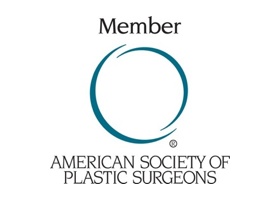
 3510 N. Ridge Rd, Suite 100
3510 N. Ridge Rd, Suite 100